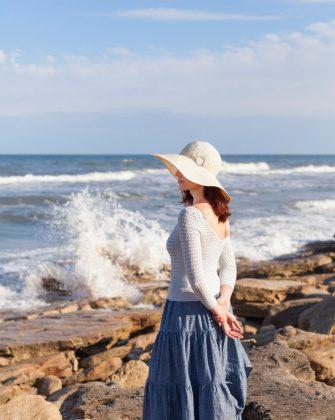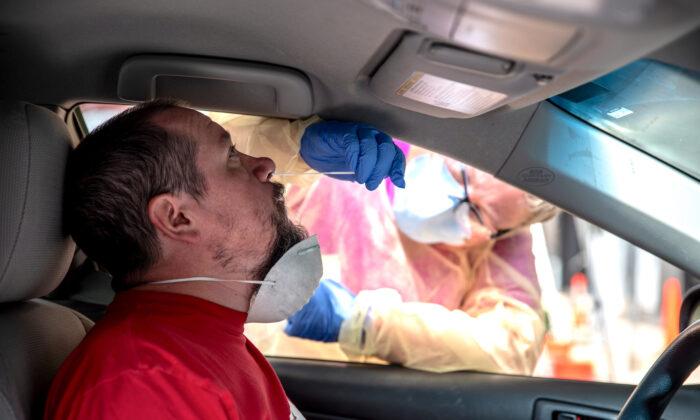The hot weather and beating summer sun mean light breezy fabrics. Bare arms and legs are now a common sight on sun drenched city streets—the stuff of dermatologists’ nightmares.
Summer Kramer, founder of SummerSkin, a line of skin-protective clothing for the fashion conscious, explains what fabrics and accessories offer the best sun protection. Answers have been edited for clarity and brevity.
Epoch Times: What misconceptions do you find we have about the sun protection afforded by different fabrics?
Summer Kramer: I find that there are many misconceptions about fabrics and how they protect your skin. The example I typically use is that the standard white cotton T-shirt has a rating of approximately UPF 5. UPF, which stands for Ultraviolet Protection Factor, is a similar standard to the SPF of sunscreen, but it’s the rating that’s applied to textiles.
Most people wouldn’t bother slathering on a sunscreen with a rating of only SPF 5, and we [at SummerSkin] think that clothing should be the same way.
SummerSkin [fabrics] have the highest UPF rating possible (50+), without the use of chemical treatment.
Epoch Times: You developed melanoma on your leg, why do you think it appeared there?
Ms. Kramer: I directly attribute the development of melanoma on my leg to my use of tanning beds during my late teens and early 20s. Like most women that age, I felt invincible and never thought that I could develop cancer that young, but I was wrong.
Epoch Times: What should we consider when choosing summer fabrics?
Ms. Kramer: The first thing to consider is that the fabric’s sun-protective qualities must be inherent in the fabric—[at SummerSkin] we never use fabrics that are chemically treated or embedded with nanoparticles to become sun-protective. The UPF of any fabric is determined by the tightness of the weave/knit, its thickness, and the color—a darker color is innately more sun-protective than a lighter color.
Epoch Times: What are your top choices for skin-protective accessories?
Ms. Kramer: The key to accessories is to find ones that make you feel fabulous. I look for floppy sun hats, scarves, and sunglasses with wider frames for the most coverage (think Jackie Onassis). Accessories are an easy way to cover up quickly and are very easy to pack or carry with you wherever the sun takes you.
Epoch Times: What should people consider when choosing a sun hat?
Ms. Kramer: It’s all about coverage and shade—think of your hat as an umbrella for your head. You want to make sure you choose something with a large enough brim that will keep the sun off of your face. This is also a good way to keep the sun off the back of your neck. Only hats that have been certified as sun-protective will have the UPF rating on the label.
Epoch Times: What should we look for in sunglasses?
Ms. Kramer: Again, coverage is key. Ocular melanoma is on the rise, and the skin around our eyes is particularly delicate and susceptible to aging, so it’s important to get the proper coverage from your sunglasses, as well as UVA/UVB protection in the lenses.
Epoch Times: Sunscreens can be super confusing, what tips do you have for choosing one to wear?
Ms. Kramer: You want to wear a broad-spectrum sunscreen that is at least 30 SPF, and make sure to follow the instructions on the bottle about reapplying every two hours when you’re outside. Waterproof is also a great idea, but again, reapplying every two hours is the key to getting the full benefit of the sunscreen.
Epoch Times: You use fabric blends like bamboo viscose, cotton, and spandex. What is it about these that help guard against sun exposure better than other similar weight fabrics?
Ms. Kramer: Because the fibers in these fabrics are thinner, they are able to be woven or knit more tightly, which greatly increases the fabric’s sun-protective qualities.
Epoch Times: You make denim items out of 100 percent Tencel denim. What is this and why do you use it?
Ms. Kramer: Tencel is a biodegradable fiber made from wood pulp. [SummerSkin makes theirs from sustainably harvested trees.]
While typical denims do offer high levels of sun protection, they also tend to be heavier in weight and aren’t ideal for wearing in warmer weather conditions, especially when humidity is high.
The tightly woven Tencel denim that we use in our pants offers the highest rating of sun protection (UPF 50+), while also being softer, more lightweight, and more breathable than traditional denim. It is also moisture-wicking and, due to being so lightweight, dries very quickly.
Epoch Times: Anything else we should know?
Ms. Kramer: Skin cancer diagnoses around the world are at epidemic levels with more and more cases being discovered every day. In light of my own experience with skin cancer, educating people and raising awareness about the importance of sun protection is a passion for me.
[At SummerSkin] we hope that someday soon, sun-protective clothing becomes as routine as buckling your seat belt in a car—something that we put on automatically without even having to think about it.







Friends Read Free